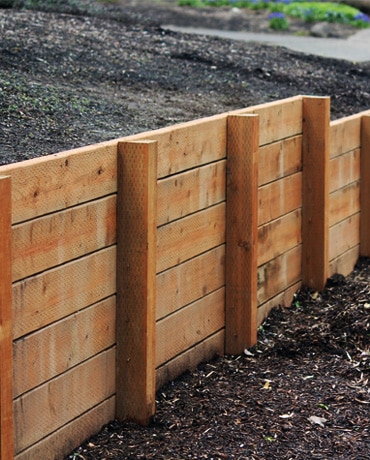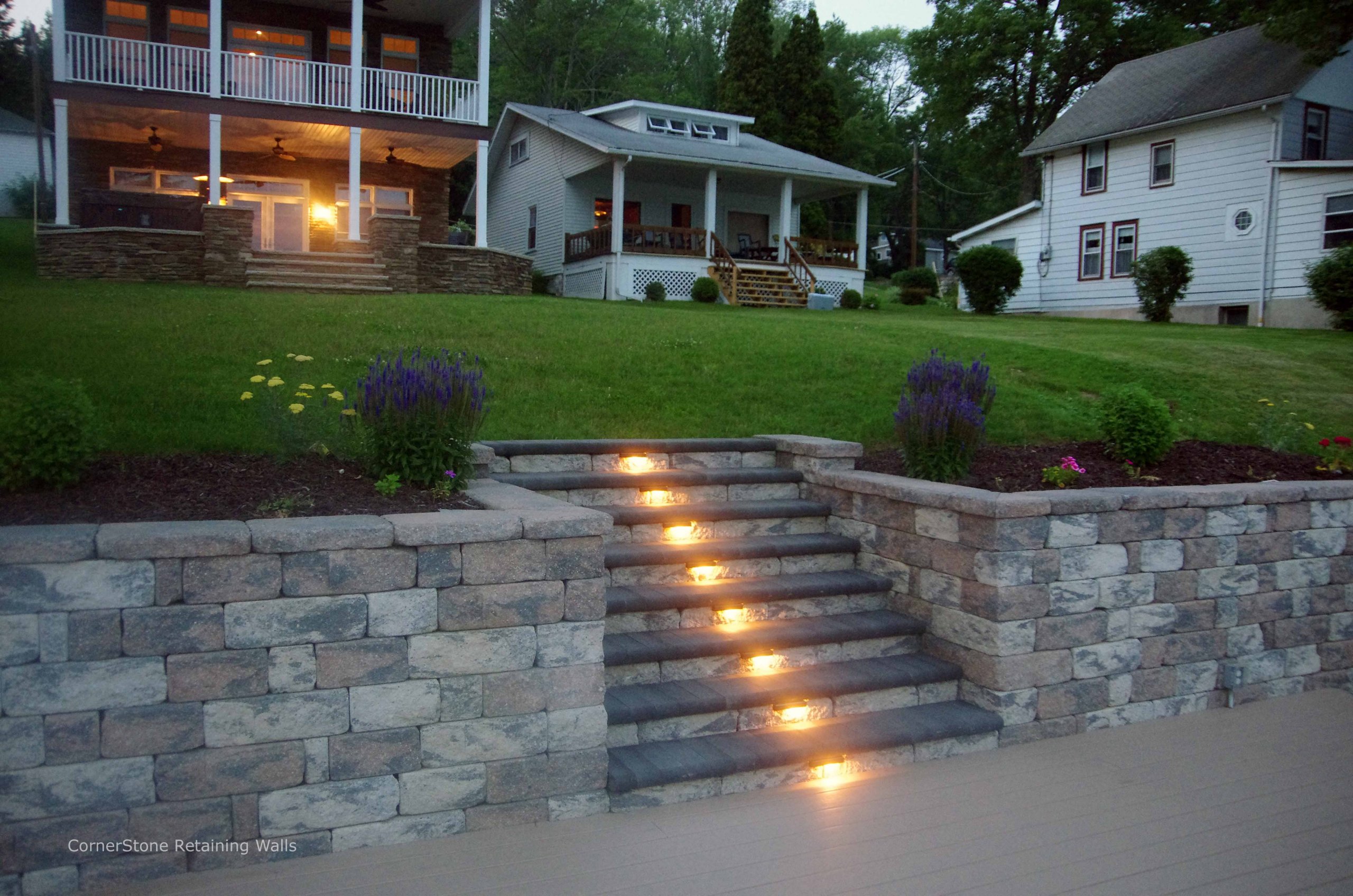Making Sure Architectural Honesty: The Importance of Correctly Created Keeping Walls in Stopping Slope Failure
In the realm of civil engineering and building and construction, the significance of properly constructed retaining walls in averting slope failing can not be downplayed. These structures serve as important safeguards against the natural pressures that can destabilize slopes and cause possibly tragic effects. Recognizing the careful design considerations, building and construction techniques, and maintenance techniques linked with retaining walls is essential in guaranteeing their efficacy and longevity. By exploring the elaborate interaction between these aspects, a deeper understanding of the essential role that keeping walls play in protecting architectural stability and protecting against incline failure emerges. Retaining Walls Sunshine Coast.
Role of Retaining Walls in Stability
The indispensability of preserving wall surfaces in making certain slope security is vital in civil design practices. Preserving wall surfaces offer a crucial function in preventing dirt erosion, taking care of water runoff, and keeping the architectural stability of inclines. By supporting near-vertical or upright quality changes, retaining wall surfaces help to redistribute lateral pressure put in by the dirt, thus reducing the threat of incline failing.
One secret function of maintaining walls is to neutralize the pressure of gravity acting upon the dirt mass behind them. This is accomplished through appropriate style and building, which thinks about factors such as dirt kind, wall surface elevation, drainage arrangements, and potential surcharge loads. By properly preserving dirt within defined limits, these frameworks aid to support inclines and prevent landslides.
Additionally, maintaining walls add to the aesthetics of landscapes while providing functional advantages. They can develop terraced degrees for landscape design, support roads or structures on hillsides, and enhance the general functionality of sloped surface. Essentially, keeping wall surfaces play an essential role in maintaining incline security and making certain the safety and security and durability of civil engineering tasks.
Aspects Influencing Wall Surface Performance
Variables that affect the performance of maintaining wall surfaces include soil residential properties, wall design, and external loads. Dirt buildings play a crucial duty in figuring out the security and performance of a retaining wall. Elements such as soil kind, cohesion, internal friction angle, and groundwater problems can influence just how well a wall preserves the soil behind it. The design of the retaining wall is an additional key factor that affects its performance. Correct wall surface layout thinks about aspects like wall elevation, wall surface kind (e.g., gravity walls, cantilever walls), reinforcement materials, drain systems, and building techniques to make sure the wall surface can hold up against the lateral pressure exerted by the maintained soil. Additionally, external loads, such as surcharge tons from nearby structures or traffic, seismic pressures, and water pressure, need to be very carefully assessed during the design and construction stages to guarantee the wall surface can sufficiently stand up to these exterior forces. By taking into consideration these aspects thoroughly, engineers can create keeping wall surfaces that successfully avoid slope failing and guarantee lasting structural integrity.
Style Considerations for Preserving Wall Surfaces
Incorporating the important elements of soil residential or commercial properties and external tons right into the architectural style process is necessary for establishing effective preserving wall surfaces that make certain slope stability. When developing maintaining walls, designers should thoroughly review the characteristics of the bordering soil, including its compaction, drainage, and type homes. Recognizing these dirt residential or commercial properties is crucial for figuring out the proper wall surface height, thickness, and reinforcement required to hold up against the lateral stress exerted by the soil mass.
Additionally, outside lots such as surcharge loads from nearby structures or website traffic, in addition to seismic forces, resource must be thought about during the design stage. These loads can dramatically affect the stability and efficiency of a keeping wall surface, demanding making use of correct style methods and materials to alleviate potential failure dangers.
Furthermore, the option of suitable products, such as concrete, stone, or hardwood, must line up with the site-specific problems and aesthetic needs. Aspect of safety and security considerations, water drainage arrangements, and construction techniques are also vital elements that affect the overall design and functionality of maintaining wall surfaces in stopping slope failure. By very carefully considering these layout factors to consider, designers can make certain the structural honesty and lasting security of retaining walls.

Building And Construction Best Practices for Resilience
When constructing preserving walls for optimal resilience and longevity, adherence to industry-standard strategies and precise focus to detail are paramount. To guarantee the resilience of a retaining wall surface, proper site prep work is vital.
Including reinforcement methods, such as geogrids or steel bars, can boost the architectural integrity of the maintaining wall and stop possible failures. Appropriate backfilling treatments, consisting of compaction and water drainage considerations, are likewise essential for the wall's sturdiness. Regular upkeep and examinations are recommended to address any type of indications of wear, disintegration, or structural issues quickly. By following these building ideal techniques, preserving walls can withstand the test of time and efficiently avoid incline failing.
Relevance of Correct Upkeep
Normal maintenance is crucial for maintaining the architectural stability and capability of preserving wall surfaces in time. Ignoring maintenance can bring about problems such as erosion, splits, or perhaps total failure of the wall, threatening the security of the slope it sustains. To guarantee that retaining walls proceed to do their designated feature efficiently, normal examinations should be conducted to recognize any type of signs of damage. These assessments can help in detecting very early indication of possible issues, enabling Visit Website timely repairs to be accomplished before the concerns intensify (Retaining Walls Sunshine Coast).

Conclusion
To conclude, maintaining wall surfaces play a crucial role in ensuring architectural integrity and avoiding incline failing. By taking into consideration elements influencing wall effectiveness, adhering to develop considerations, following building best techniques, and applying correct upkeep, the toughness of preserving wall surfaces can be made best use of. Retaining Walls Sunshine Coast. It is necessary to acknowledge the significance of correctly constructed retaining wall surfaces in preserving stability and protecting against potential dangers related to incline failing
Aspects that influence the effectiveness of retaining wall surfaces include soil homes, wall layout, and external lots. Appropriate wall surface style thinks about variables like wall height, wall surface type (e.g., gravity wall surfaces, cantilever walls), support materials, drainage systems, and construction strategies to make sure the wall can hold up against the lateral stress put in by the maintained soil. By thinking about these elements adequately, engineers can create keeping walls that successfully stop slope failure and make certain long-lasting architectural integrity.
Maintenance tasks might include getting rid of drainage systems to stop water buildup click reference behind the wall surface, repairing any kind of noticeable cracks or damages, and ensuring that the wall is totally free from plant life that might apply stress on the framework. By considering factors influencing wall effectiveness, adhering to make considerations, adhering to construction ideal techniques, and implementing proper maintenance, the toughness of retaining wall surfaces can be taken full advantage of.